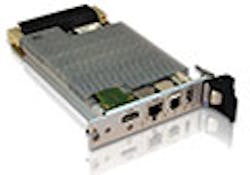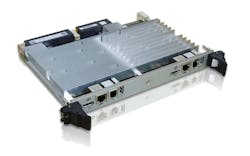VPX Enables Continued Electronic Warfare/Sensor Processing System Innovation
Author: Mark Littlefield, Defense Vertical Product Manager at Kontron America - an S&T Company
The VPX form factor is used today for a wide range of applications and deployed environments. Applications vary from rail management systems to AESA Radars on high-performance fighter aircraft, and environments vary from lab-benign (or near-lab conditions like wide-body jets) to tracked vehicles and unpressurized bays in high-altitude UAVs. The natural ruggedness and huge bandwidths provided by VPX make it a natural choice for many projects. However, one application space which benefits greatly from the power of VPX is electronic warfare (EW) and military sensor processing (SP) systems.
Military EW and SP systems are among the most challenging embedded systems to design and deploy. Not only do they require voracious amounts of signal processing, they also often require more mundane server-style processing (for signal library maintenance, data logging, etc.) and are deployed in a variety of deployed environments. Frequently these systems must be packaged in extremely size, weight, and power (SWaP)-constrained environments such as under wing pods. As a result, advanced EW/SP systems can benefit from consolidating workloads on a single machine with the means to efficiently execute these two very different processing problems using parallel virtual machine (VM) execution.
“System developers can integrate multiple functions onto a common platform, extending the capabilities of their systems while driving down overall SWaP requirements”
Modern commercial off-the-shelf (COTS) 3U VPX single-board computers based on Intel server-class processors are a compelling option for these sorts of systems. Leveraging the consumer electronics drive for larger numbers of cores, streaming video and audio processing, and greater integration, Intel and other processor suppliers are offering components with these features. They also include the added bonus of extended temperature ratings and longer-than-typical consumer life cycles that can satisfy lengthier embedded defense application lifespans. Boards and system suppliers are making use of these components and developing both board-level and packaged systems solutions that simultaneously push performance limits and I/O features while maintaining tough SWaP limits and driving down costs. This approach is a real win for the EW market, which generally will use every ounce of performance they can fit into a package.
High-density EW/SP platforms that, for example, integrate the server-class Intel Xeon processor D-1540, provide the basis for continued innovation. Taking advantage of its multi-core/multi-thread capabilities, system developers can integrate multiple functions onto a common platform, extending the capabilities of their systems while driving down overall SWaP requirements. For instance, developers can use such systems to powerfully consolidate workloads into a single system to run both jamming and surveillance EW applications. View the VPX Video.
Another key feature of the Intel Xeon-D processor is its digital signal processing (DSP) capabilities offered by the AVX2 floating-point vector math units. EW/SP systems rely heavily on signal or image processing, which means that maximizing the number floating point (or double-precision) operations that a processor can calculate per second is key to mission success. The Xeon-D provides two 256-bit floating point vector units, each supporting a multiply/accumulate operation. This means that, when running at 1.7 GHz, this processor can generate more than 432 billion floating point operations per second. Additional features to support this massive floating point performance include multiple lanes of PCI Express (PCIe) Gen3 and 10 Gigabit Ethernet (GbE) that deliver extremely fast and low latency transfers. Finally, the Xeon-D provides a rich assortment of support functions and peripheral I/O such as SATA III and virtualization technology (IntelVT), which enables the system developer to efficiently share the processing hardware for both math-intensive and more classical data processing tasks. This functionality makes it an ideal platform for EW and SP applications.
VX3058 Octo Core Intel® Xeon® Processor OpenVPX™ Server Blade
Kontron makes use of the power of both VPX and the Intel Xeon-D in two flagship products for EW and SP – the VX3058 and the VX6090 3U and 6U OpenVPX modules. The VX3058 is a 3U VPX platform using the 8-core (or optional 4-core) Xeon D-1500 running at 1.7 GHz and features two channels of ECC DDR4 SDRAM (up to 32 GBytes). The VX3058 also supports features such as PCI Express Gen2 links, 10 Gigabit Ethernet links, SATA III, Gigabit Ethernet, XMC site, M.2 site for a solid-state drive, and an optional graphics module, and is available in commercial grade (SA), extended air-cooled (RA), or rugged conduction-cooled (RC) variants. This makes the VX3058 a powerful, flexible platform ideal for tough EW and SP systems requiring optimum SWaP in a compact package.
VX6090 6U VPX Intel® Dual 8-Core Xeon® D Multi-Processing Board
The VX6090 essentially offers two VX3058 compute nodes on one 6U OpenVPX module. The larger size of the 6U VX6090 means that more backplane pins are available for somewhat richer I/O and the better cooling provided by the greater board area of the 6U means that processing speeds increase to 2 GHz. For EW and SP systems which require a maximum of DSP and general purpose processing performance, the VX6090 fills that need, with the same large PCIe and 10 Gigabit Ethernet pipes and ruggedization options provided by its smaller sibling.
Each generation of EW systems increases the demands for high-performance processing and increasingly larger bandwidth for both streaming data in and out of the system as well as for inter-processor communications. Military systems designers face an ever-growing need to meet escalating requirements and provide platforms that can be packaged and deployed in harsh environments. Kontron strives to leverage the best, most ideal computing, communications, and peripheral components to develop best-in-class rugged computing and high-performance networking switch modules for the demanding electronic warfare and sensor processing community. To learn more about the full range of Kontron’s VPX products please visit https://www.kontron.com/products/boards-and-standard-form-factors/vpx



